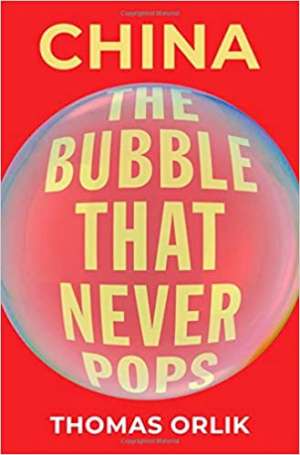26 November 2020
China:
The Bubble That Never Pops
Tom Orlik
2020, Oxford University Press, 240 pages,
ISBN 9780190877408
Reviewer: Andrew Peaple

Anyone interested in China’s economy will have become used over the years to books predicting either the country’s coming global triumph, or its imminent demise. One veteran wag in the Beijing foreign press corps used to joke that when the time came to write his tome it would be called ‘The Muddle Kingdom: How China Gets Through the Day’, just for the sake of contrast.
Tom Orlik echoes this spirit with his book ‘China: The Bubble That Never Pops’, in which he takes aim at what he calls ‘Sinophrenia’ – the simultaneous belief that Chins is about to collapse, and about to take over the world. He instead explains the underlying strengths that have kept the Chinese economic show on the road through decades of expansion — only recently, and apparently briefly, interrupted by the coronavirus — and how it has continually defied the doomsters, despite several hairy moments along the way.
Orlik is well placed to offer this review. Now the chief economist at Bloomberg, he lived and worked in China for several years, including a stint at The Wall Street Journal where — full disclosure — we were colleagues for a while. While he has the academic chops to analyse China’s economy his book is entertainingly written, with sets of bullet points summarizing his argument scattered through its chapters. As befits a former journalist Orlik is good, too, at finding real-life examples that help to illustrate his argument.
Orlik cites the following as key factors in China’s favour: its continually high domestic savings rate and still largely closed capital account that means its major banks never face a serious funding issue; its abundant space still to grow given the still low level of average incomes; the fact that important reforms are in train, such as the decade-long marketization of interest rates; and the presence of policy makers who – while not being omniscient – are experienced in dealing with periodic crises.
He reminds the reader, too, that while there has no doubt been major misallocation of capital during the last decade or so of debt-fuelled expansion, not all of it will have been wasted. “The state-owned firm that builds a bridge or high-speed rail link or water treatment plant might not generate much income,” he writes. “The firms and households that use the new facilities do. Ultimately – China’s government hopes – that will result in enough tax revenue to make everyone whole.”
The book takes the reader on through a concise and eminently readable history of China’s modern economy, detailing how various difficulties were overcome, including China’s response to the global financial crisis and the domestic stock market crash and yuan devaluation of 2015. Along the way he explains the system’s vulnerabilities and how they came about, including the explosion in China’s local government debt and the rapid growth of its shadow banking system. Useful comparisons are made with the development of Japan and South Korea’s economies, helping to put the problems in China’s system into context.
So, can the bubble go on expanding? Orlik posits a “plausible but pessimistic” near-term scenario, in which China’s shrinking labour force, a continued trade war with the US and stalled domestic reform start to bite, with the system unable to respond in its time-honoured investment-led way given already stratospheric debt levels.
But true to his phlegmatic approach throughout the book, Orlik argues that China’s fundamental strengths still offer a “ready-made blueprint for development” that should yet prove resilient. China sceptics, he argues, underestimate its policymakers’ ability to handle seemingly intractable trade-offs, such as the need to tame property prices without cratering the construction industry, or reforming the state-owned sector without losing a vital tool of political control. He acknowledges, too, the fact that when all else fails China’s policy makers can fall back on the “unusual resources of a Leninist party state. Chief among these is the ability to shift policy decisively…without regard to procedural or legal niceties.”
Orlik may well be right that a crisis that brings the whole structure crashing down is unlikely in China. Nonetheless, the policy issues facing the Beijing leadership are arguably harder now that any time in China’s reform and opening-up era, with the outside world more hostile and the need internally to avoid the middle-income trap and tackle widening wealth inequality. Hopefully Orlik will be on hand to chart the next stage of China’s development as ably as he has done for its previous cycles in this book.
